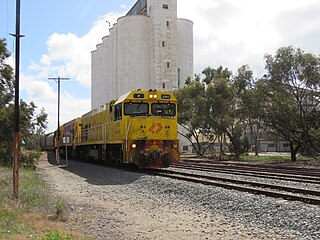Related Research Articles

The AvonLink is a rural passenger train service in Western Australia operated by Transwa between Midland and Northam.

The Prospector is a rural passenger train service in Western Australia operated by Transwa between East Perth and Kalgoorlie. On this service, two trains depart almost at the same time in opposite directions, one travelling between East Perth and Kalgoorlie, and the other between Kalgoorlie and East Perth. The original vehicles ordered in 1968 for trains providing this service were replaced in 2004 with vehicles capable of reducing journey times to 6 hours 45 minutes.

The Australind is a currently suspended rural passenger train service in Western Australia operated by Transwa on the South Western Railway between Perth and Bunbury.

Western Australian Government Railways (WAGR) was the state owned operator of railways in the state of Western Australia between October 1890 and June 2003. Owned by the state government, it was renamed a number of times to reflect extra responsibility for tram and ferry operations that it assumed and later relinquished. Westrail was the trading name of the WAGR from September 1975 until December 2000, when the WAGR's freight division and the Westrail brand were privatised. Its freight operations were privatised in December 2000, with all remaining passenger operations transferred to the Public Transport Authority in July 2003.

The Midland Railway of Western Australia (MRWA) was a railway company that built and operated the Midland line in Western Australia. It was listed on the London Stock Exchange. Although having its headquarters in London, it had no association with the English Midland Railway.

The Westland was the name given in 1938 to the overnight train operated by the Western Australian Government Railways (WAGR) with sitting and sleeping cars between Perth and Kalgoorlie, where it connected with the Trans-Australian service to Adelaide.
The Albany Progress was an overnight passenger train operated by the Western Australian Government Railways between Perth and Albany via the Eastern and Great Southern lines from May 1961 until December 1978.

Railways in Western Australia were developed in the 19th century both by the Government of Western Australia and a number of private companies. Today passenger rail services are controlled by the Public Transport Authority through Transperth, which operates public transport in Perth, and Transwa, which operates country passenger services. Journey Beyond operates the Indian Pacific.

The ADK class are a class of diesel multiple units that were previously operated by Western Australian Government Railways (WAGR) in Perth, and later Transdev Auckland on Auckland's suburban rail network, and are currently operated by MetroBus in Maputo, Mozambique. Originally built by Commonwealth Engineering and the Midland Railway Workshops for WAGR in the late 1960s, all but one were sold in 1993 to New Zealand Rail, and were then owned by Auckland Transport. The units were completely withdrawn from service in New Zealand on 5 December 2014, following completion of electrification of Auckland's network.
The Mullewa was an overnight passenger train operated by the Western Australian Government Railways between Perth and Mullewa in the Mid West Region via the Eastern and Northern lines.
The Northern Railway has had a number of meanings in Western Australian railway history.

The South Western Railway, also known as the South West Main Line, is the main railway route between Perth and Bunbury in Western Australia.

The WAGR ADE class was a six member class of diesel railcars operated by the Western Australian Government Railways between 1937 and 1962.

The WAGR ADF class was a six member class of diesel-electric railcars operated by the Western Australian Government Railways between 1949 and 1975.

The Midland railway line historically ran from Midland Junction to Walkaway in Western Australia. Built by the Midland Railway of Western Australia, the 446 kilometre line opened in November 1894.
The WAGR ADH class was a four member class of diesel railcars operated by the Western Australian Government Railways.
The Bunbury Belle was a passenger train operated by the Western Australian Government Railways between Perth and Bunbury via the South Western line from June 1964 until July 1975.
The Shopper was a passenger train operated by the Western Australian Government Railways between Perth and Bunbury via the South Western line from June 1964 until July 1975.

The Northcliffe Branch, also known as the Northcliffe Section or Picton to Northcliffe Line, is the railway route between Picton and Northcliffe in Western Australia.

WAGR G class G233 Leschenault Lady is a preserved 2-6-0 steam locomotive, built in 1898 by James Martin & Co of Gawler, South Australia, for the Western Australian Government Railways (WAGR). It is the third oldest Australian-built steam locomotive still in operational order, after Victorian Railways Y class 112 and WAGR A class 15.
References
- ↑ Western Australian Government Railways Commission (1964), Midlander buffet car and hostesses, 18 August 1964 , retrieved 23 August 2024
- ↑ Gunzburg, Adrian (1989). The Midland Railway Company Locomotives of Western Australia. Surrey Hills: Light Railway Research Society of Australia. p. 47. ISBN 0-9093402-77.
- 1 2 May, Andrew S; Gray, Bill (2006). A History of WAGR Passenger Carriages. Midland, WA: Bill Gray. p. 260. ISBN 0646459023.
- 1 2 Higham, Geoffrey (2007). Marble Bar to Mandurah: A history of passenger rail services in Western Australia. Bassendean: Rail Heritage WA. pp. 118, 119. ISBN 978-0-9803922-0-3.